Revitalize Your Bathtub: Tips for Pristine White
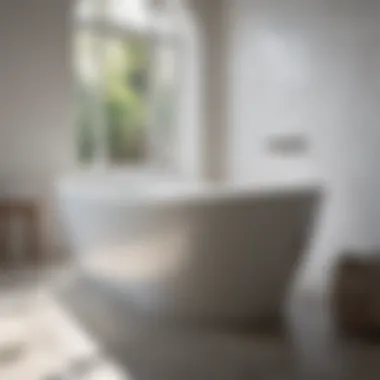
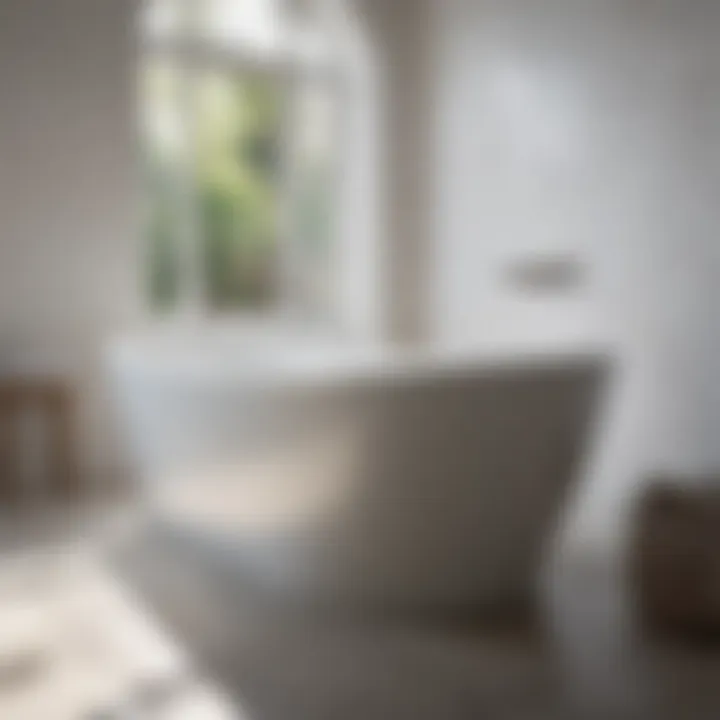
Intro
Bathtubs, often the centerpiece of bathrooms, sometimes wear the marks of time and usage. A once pristine white surface can become dingy, stained, or yellowed due to age, harsh cleaning products, or simply the passing of years. Many homeowners find themselves in a quandary, trying to restore that gleaming finish that first drew them to their tub. Fortunately, with the right knowledge and a few simple techniques, one can achieve significant transformations.
Importance of Restoration
Restoring a bathtub isn't just about aesthetics. A clean, bright tub enhances the overall look of a home, inviting relaxation and tranquility into the bathing experience. Furthermore, a properly maintained tub can prevent corrosion and potential damage, thereby extending its lifespan. Ultimately, a rejuvenated bathtub offers both beauty and functionality, revitalizing the entire bathroom space.
Overview of the Article
This guide will take you through effective cleaning methods, materials suited for various types of bathtubs, and sustainable practices that align with a modern, eco-conscious lifestyle. We’ll also touch upon current trends in bathroom design that highlight the importance of maintaining the beauty of your bathing sanctuary. Buckle up and prepare for a journey to rediscover the pristine white allure of your bathtub.
Preamble to Bathtub Discoloration
Bathtubs often serve as the centerpiece of our bathrooms, a sanctum for relaxation. However, maintaining their pristine appearance can be a daunting task for many homeowners. Discoloration not only detracts from the aesthetic appeal of a bathroom but also raises concerns regarding cleanliness and hygiene. This article addresses the key aspects of bathtub discoloration, offering insights on causes and remedies that ensure your tub gleams like new.
Understanding the origins of stains and marks is crucial for a well-planned cleaning strategy. By diagnosing the stain type, homeowners can choose suitable cleaning options that won't damage the material. Factors like water quality play a significant role, greatly influencing the longevity and visual state of the tub. Adopting effective cleaning techniques not only restores your bathtub's shine but also prolongs its lifespan, providing sustained value for your home.
Causes of Bathtub Stains
The culprits behind bathtub stains are numerous, each with its characteristic effects. It's not just a simple matter of dirt; often, discoloration can result from a mix of household habits and external factors. For instance, if you have children or pets, frequent splashes or accidents can lead to marks that seem nearly permanent.
Another common issue arises from the rusting of metal fixtures or pipes, a process that introduces unsightly brown or reddish stains onto surfaces. Furthermore, if you typically shower with soaps or shampoos containing artificial dyes, residues may build up and leave noticeable rings around the tub.
In addition, mold and mildew can also wreak havoc on the tub's appearance, especially in areas with high humidity. These troublesome fungi can form unsightly black or green patches, leading to an environment that feels more like a swamp than a sanctuary. Adopting a thorough understanding of these causes provides the foundation for better maintenance and the implementation of more effective cleaning techniques.
Impact of Water Quality
Water quality is a significant player in the drama of bathtub maintenance. Hard water, rich in minerals such as calcium and magnesium, can create stubborn deposits, often referred to as limescale. A buildup of these minerals can obscure the smooth finish of your tub, leading to unsightly spots that require specialized remedies.
To elaborate further, the presence of chlorine and other chemicals in water can have a bleaching effect over time. Thus, while hard water can leave crusty deposits, chemically treated water may cause gradual fading. This duality underscores the importance of water testing, allowing homeowners to take appropriate action and incorporate water softeners or filtration systems as needed.
In essence, both the chemistry of your water and your daily practices can significantly impact the integrity of your tub's surface. By addressing these factors upfront, you can set the stage for a cleaner and more visually appealing bathing space.
"A clean bathtub is not just aesthetics; it's also an invitation to relaxation. And who doesn't deserve that?"
Equipped with this knowledge, you'll understand that restoring the whiteness of your bathtub is a journey that starts with recognizing what contributes to its decline in appearance. The following sections will provide practical guidance on assessing the bathtub material and effective cleaning techniques.
Assessing Your Bathtub's Material
Acrylic Bathtubs
Acrylic bathtubs are lightweight, non-porous, and generally easier to clean than other materials. These tubs have the advantage of retaining heat well, and they come in various shapes and sizes, making them an appealing choice for many homes. However, they can scratch easily, which is something to keep in mind.
To restore the whiteness of an acrylic tub, common ingredients like baking soda and vinegar can effectively help without causing damage. A mixture of these two creates a paste that serves as a gentle abrasive.
Important tips for cleaning acrylic tubs:
- Avoid harsh chemicals, especially those containing bleach, as they can dull the finish.
- Use soft sponges or microfiber cloths to prevent scratches.
- Always rinse thoroughly after cleaning to prevent residue buildup, which can lead to dullness over time.
Porcelain Bathtubs
Porcelain bathtubs exude a classic feel with their smooth, glossy finish. Made of cast iron or steel coated with porcelain enamel, these tubs are durable and resistant to staining but can suffer from chips and scratches if not handled properly. Their ability to maintain heat makes them popular, but once they get discolored, they can be a bit tricky to clean.
For porcelain, a mixture of baking soda and water works wonders. This combination not only removes stains but also polishes the surface to some degree. Be cautious though; abrasive tools are a no-go with porcelain as they can exacerbate any chips.

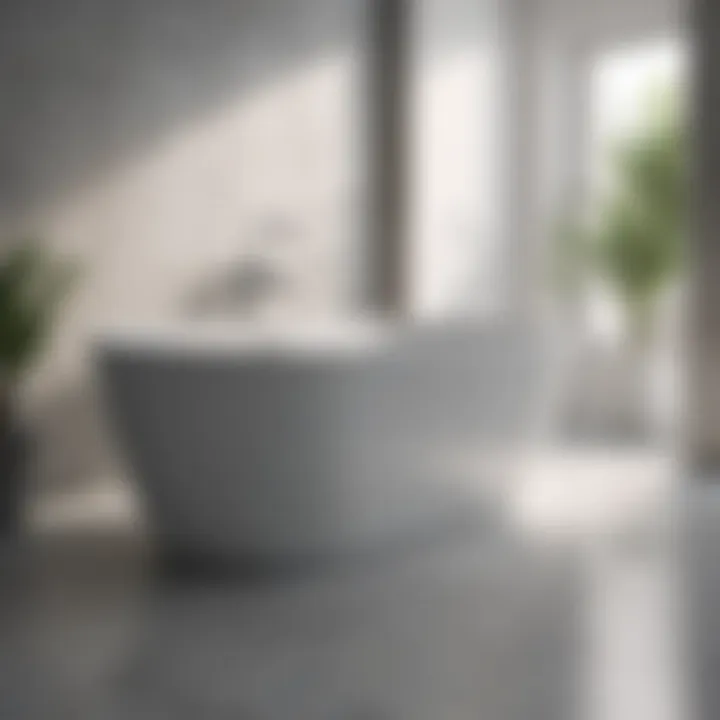
Key pointers for porcelain tub care:
- Avoid using gritty cleaners or steel wool.
- Routine cleaning with a gentle detergent and water can help maintain the shine.
- If there are tough stains, consider a non-abrasive cleaner specifically designed for porcelain.
Fiberglass Bathtubs
The appeal of fiberglass tubs lies in their versatility and affordability. They are lighter than porcelain or acrylic and can be molded into various designs. However, fiberglass can become scratched or stained over time and is more susceptible to UV damage.
Cleaning these tubs requires some extra caution. A gentle cleaner combined with a soft cloth is usually the best path forward. For stubborn stains, a paste of baking soda and vinegar may be effective. It's vital to rinse well to avoid any residue that might lead to new stains.
Cleaning and care tips for fiberglass tubs:
- Avoid cleaners with petroleum-based products or harsh chemicals.
- Try to use a soft cloth or sponge and be gentle when scrubbing.
- Make sure to dry the surface to prevent water spots and discoloration.
Understanding your bathtub’s material is not just about cleaning; it's about nurturing your space to keep it looking its best for years to come.
Essential Cleaning Ingredients
Cleaning a bathtub is not just a minor chore; it often takes some elbow grease and the right mix of ingredients to turn a discolored tub back to its dazzling white. The essential cleaning ingredients are pivotal in this journey, as they serve different functions and come with their own set of benefits. Choosing the right elements is crucial not only for efficiency but also for maintaining the longevity of your tub's materials.
Effective cleaners can mean the difference between a sparkling tub and one that still looks cloudy despite your efforts. The key here is understanding how certain ingredients react with various stains and bathtub materials. Let's dive into some game changers that will make your cleaning routine as smooth as a baby’s bottom.
Vinegar's Role
Vinegar isn’t just a staple in your kitchen, it’s a powerhouse when it comes to cleaning. This common ingredient contains acetic acid which breaks down mineral deposits, soap scum, and grime like it's nobody’s business. Whether you’re dealing with stubborn discoloration or hard water stains, a bottle of white vinegar can come to the rescue.
The best part? It’s non-toxic and won't leave you gasping for air after using it, unlike some chemical cleaners. To utilize vinegar effectively:
- Mix it with water (50/50 solution) for a less concentrated cleaner for routine maintenance.
- Spritz it directly onto tough stains and let it sit for 15-20 minutes before scrubbing.
Not only does vinegar help in cleaning, but it also neutralizes odors. Give your bathtub a quick wipe-down with this homemade solution to keep it fresh between deep cleans. Just remember, while vinegar works wonders, it’s not a miracle worker for all stains, particularly oil-based ones.
Baking Soda as an Abrasive
Think of baking soda as your tub's best buddy when it comes to tackling scuffs and tough stains. It’s a safe, naturally occurring abrasive that can lift grime without scratching most surfaces. So when you're ready to scrub, baking soda should be in your arsenal.
Here’s how to maximize its effectiveness:
- Sprinkle a thick layer of baking soda directly onto the stained area.
- Add vinegar on top of the baking soda. This will create a delightful fizz that lifts dirt and stains as it works its way down.
This combination is especially effective for those stubborn yellow stains often found around the drain. The following steps can lead to a crystal-clear tub:
- Allow the mixture to sit for about 30 minutes.
- Use a non-abrasive sponge or cloth to scrub in a circular motion.
This duo of ingredients does not just cleanse; it also leaves your bathtub gleaming as if it were brand new, taking away the need for harsh, commercial products.
Commercial Cleaners: Pros and Cons
In a world filled with commercial cleaners, it can be tempting to go for flashy bottles with eye-catching labels. While some of these products promise instant results, they come with a mixed bag of advantages and disadvantages.
Pros:
- Many commercial cleaners are specially formulated for specific stains or types of materials, which can make them very effective.
- They are often user-friendly and can require less preparation than homemade solutions.
Cons:
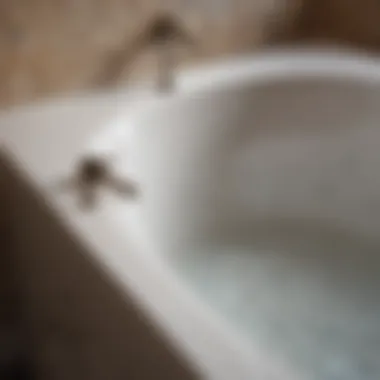
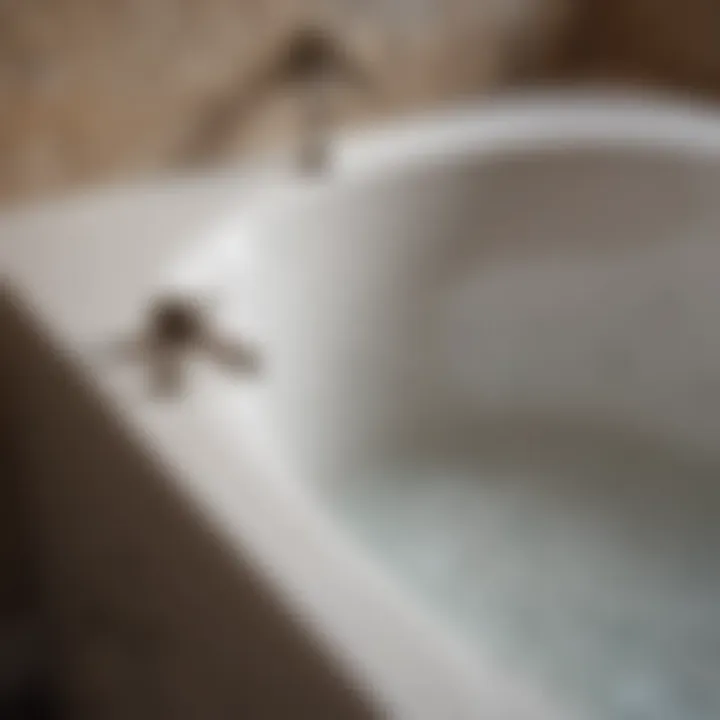
- Some products may contain harsh chemicals that can damage certain bathtub materials. For example, acids can harm fiberglass over time.
- Environmental Impact: Conventional cleaners often come in plastic bottles and can release harmful chemicals into the water supply upon disposal.
It's wise to carefully read the labels, checking for any harmful substances that could compromise both your health and your tub’s surface. If you still choose to use commercial products, consider looking into greener alternatives that minimize environmental damage.
"Choosing the right cleaner not only impacts the cleanliness of your tub but also its lifespan. Not all cleaners are equal, and understanding your options is key."
In the end, the ingredients you opt for will guide your cleaning success, ensuring your bathtub shines like it did on day one.
Step-by-Step Cleaning Process
Cleaning your bathtub isn’t just a chore; it’s an essential way to maintain its lifespan and aesthetic appeal. Ensuring that this space remains inviting doesn’t happen by chance—rather it requires a systematic approach to restore that pristine white finish. This section provides a detailed, step-by-step breakdown of how to effectively clean your bathtub, which can help you save time and prevent potential issues such as damage to the material.
Preparation of the Area
Before diving into the cleaning process, taking a moment to prepare the area is crucial. Start by removing any items from around the bathtub: toiletries, bath mats, and maybe even a few forgotten toys. This goes beyond mere aesthetics; clearing the space can prevent accidental spills and scratches during scrubbing. Once the area is free, it’s a good practice to cover any surrounding surfaces with old towels or a drop cloth. Not only does this protect the floor, but it also minimizes mess if cleaning solutions splash around. Trust me, spending five minutes setting up can save you a headache later.
Initial Rinse and Inspection
Next comes the rinse. Using warm water, give your bathtub a good rinse to remove any loose debris or grime. This step helps you see the depth of the stains before you begin your cleaning efforts. It can almost feel like a pre-game warm-up; you get a feel for what you're working with. After rinsing, take a closer look at the stains. Are they superficial or have they settled in deeper? This scrutiny will guide your choice of cleaning solutions later on.
Application of Cleaning Solution
With the inspection complete, it’s time to apply your chosen cleaning solution. Whether you opt for a natural mix with vinegar and baking soda or a strong commercial cleaner, ensure even coverage across all stained areas. Remember to follow the instructions on any commercial products rigorously. Even in your home environment, things can get slippery, so using gloves is recommended. Allow the solution to sit for the suggested time, which lets it penetrate the stains effectively, much like marinating a fine cut of meat.
Scrubbing Techniques for Various Materials
Now we enter the labor-intensive phase—scrubbing. But, how you scrub depends greatly on the material of your bathtub. For acrylic bathtubs, use a soft sponge or cloth to avoid scratching, as their finish can be delicate. Porcelain may require a more abrasive touch, perhaps a nylon scrubber, but don’t go too hard; you could chip the surface. Fiberglass, on the other hand, is somewhere in between. An interesting tidbit is that for those particularly pesky stains, creating a paste with baking soda and a little water can offer an additional scrub-worthy mix. Just remember, even though this feels like hard work, the results will be worth every ounce of effort spent.
Final Rinse and Drying Methods
After all the scrubbing, don’t forget to give your bathtub a thorough final rinse to wash away any remaining residue of the cleaner or grime. A handheld showerhead can work wonders here, ensuring that every trace is gone. Once rinsed, drying is the last step. Using a soft microfiber cloth to wipe down the surfaces reduces the chance of water spots forming and gives that extra sheen. It’s a small finishing touch, but one that makes a world of difference to how your bathtub looks.
"A clean bathtub not only enhances the bathroom's look but also provides a relaxing space for rejuvenation."
Restoring the once brilliant white of your bathtub is a meticulous journey, but by following the steps laid out here, you can rejuvenate this essential space of your home with confidence.
Preventative Care for Longevity
Taking care of your bathtub doesn't just mean giving it a one-time deep clean. Instead, it’s about adopting a mindset that prioritizes its upkeep over time. Preventative care is key to ensuring that your tub remains in prime condition, warding off stains and surface damage before they even have a chance to set in. Regular care is not just about aesthetics; it plays a substantial role in prolonging the lifespan of your bathtub and maintaining its value.
Routine Cleaning Tips
Regular maintenance is the name of the game if you want to keep your bathtub looking as good as new. Here are a few strategies to incorporate into your routine:
- Daily Rinsing: It sounds simple, but rinsing your tub daily can make a monumental difference. Just a quick spray down with warm water removes soap scum and residues left from baths.
- Weekly Wipe Down: Dedicate a few minutes each week to wipe down surfaces with a soft cloth and a mild cleaner. This keeps grime from building up and reduces the need for intensive cleaning later.
- Use a Soft Scrubber: Avoid using anything too abrasive, like rough sponges or brushes, as they can scratch the surface. Instead, opt for a soft scrubber or a microfiber cloth that won’t damage your tub’s finish.
- Be Mindful of Products: Some products can do more harm than good. Opt for pH-balanced cleaners that won’t disrupt the sheen of your bathtub. Whenever possible, choose eco-friendly options.
- Act on Stains Quickly: The sooner you address a stain, the easier it is to remove. If you notice any discoloration, tackle it immediately with an appropriate solution instead of letting it set.
Use of Protective Coatings
Applying a protective coating to your bathtub can provide an extra layer of defense against stains and scratches.
- Understand the Options: There are various protective coatings available, such as polyurethane or silicone-based products. These are designed to create a moisture-resistant barrier.
- Application Guidelines: When applying a protective coating, ensure that the surface is properly cleaned and dried. Follow the manufacturer's instructions to achieve a flawless finish. In many cases, it’s advised to reapply every six months to a year, depending on usage.
- Benefits of Coatings: The right coating can not only simplify the cleaning process but also enhance the longevity of your tub. They make your bathtub easier to clean, as debris has less chance of adhering to the surface.
"An ounce of prevention is worth a pound of cure." This old saying rings especially true when it comes to maintaining your bathtub.
In summary, preventative care isn't just about looking pretty; it’s about creating a sustainable routine that supports the longevity of your tub while keeping it pristine. By investing time in routine cleaning and protective measures, you not only enhance its aesthetic appeal but also preserve its integrity for years to come.


Safety Considerations
Hazards of Chemical Cleaners
The cleaning aisle is filled with options that promise a gleaming finish. However, many of these chemical cleaners can be quite dangerous. Common hazards associated with them include:
- Skin Irritation: Many formulations can irritate skin, causing rashes or allergic reactions. If you have sensitive skin, it’s wise to opt for gentler alternatives.
- Respiratory Issues: Fumes from chemical cleaners can irritate the lungs and throat, exacerbating issues for those with asthma or other respiratory problems.
- Environmental Impact: Using harsh chemicals can lead to harmful substances entering the water system. It’s always advisable to think about the ecological footprint.
In light of these drawbacks, some may argue that even a minimal risk associated with using chemical cleaners outweighs the conveniences they offer. For those willing to roll their sleeves up, safer, homemade cleaners can achieve impressive results without the side effects.
"It’s better to be safe than sorry. Mother Nature appreciates it, so should you!"
Best Practices for Safe Cleaning
To help navigate the cleaning process while keeping safety in the forefront, consider these best practices:
- Read Labels Carefully: Before purchasing, scrutinize the product labels for hazardous ingredients. Look for certifications indicating lower toxicity levels.
- Ventilate the Area: Always open windows or doors to allow for fresh air circulation while cleaning. This reduces inhalation of any fumes.
- Wear Protective Gear: Gloves and masks might sound excessive for household cleaning, but they provide an added layer of security against potential skin contact and inhalation of fumes.
- Test Before Use: If you decide to experiment with a new product or solution, test it on a small, inconspicuous area of your bathtub.
- Opt for Natural Alternatives: Ingredients like vinegar and baking soda are not only effective but also much safer alternatives. These household staples can tackle tough stains without the harmful side effects.
Staying informed about the products you use allows for a more effective and safer cleaning experience, making your efforts to restore your bathtub as enjoyable as using it.
By prioritizing safety, you can proceed with confidence, knowing that your cleaning routine contributes positively to both your household and the planet.
Sustainable Cleaning Practices
The shift towards sustainable cleaning practices has gained much importance, especially as more people are becoming aware of the impact of their cleaning habits on the environment and their health. In the quest to restore the pristine white of your bathtub, opting for eco-friendly methods not only contributes to the longevity of the surfaces you’re cleaning but also supports greener living ideals. When we think about sustainability in cleaning, it encompasses the ingredients we use and how we manage our resources effectively.
One of the significant benefits of sustainable cleaning is the reduction in harmful chemicals that can leach into our waterways. Many traditional cleaners contain toxic substances that not only damage our bathtubs but also pose health hazards to families and pets. Taking a sustainable route not only promotes a healthier home environment but also signifies a commitment to caring for our planet. As we dive deeper into sustainable practices, there are two primary aspects worth exploring: the eco-friendly ingredients you can use and how to minimize water usage during the cleaning process.
Eco-Friendly Ingredients
When it comes to eco-friendly cleaning, you don’t have to break the bank or search high and low for specific products. Many ingredients that can help restore your bathtub's shine are already sitting in your kitchen or laundry room. Vinegar is a prime example; it's a natural disinfectant that can tackle soap scum and hard water deposits without resorting to harmful chemicals. Baking soda is another hero, offering gentle abrasion without scratching surfaces. A simple lemon juice has antibacterial properties and leaves a fresh scent too.
Here’s a short list of effective eco-friendly cleaning ingredients:
- Vinegar: Cuts through grime effectively.
- Baking Soda: Acts as a mild abrasive for scrubbing.
- Lemon Juice: Works as a natural bleach and deodorizer.
- Olive Oil: Can be used for polishing after cleaning.
- Castile Soap: A plant-based soap that is versatile and safe.
Using these ingredients can drastically reduce your carbon footprint while maintaining a clean home. Moreover, they’re safe for septic systems, ensuring there's no adverse effect on plumbing.
"Choosing natural ingredients is not just a choice for your home; it’s a choice for the world. Every small action counts in the bigger picture of environmental care."
Minimizing Water Usage
Water is a precious resource, and while cleaning, it’s easy to be wasteful without even realizing it. But, by being more conscious of how you use water in the cleaning process, you can both save money on bills and contribute to water conservation efforts. A few practices can help make cleaning your bathtub more water-efficient:
- Collecting Water: Use a bucket to rinse instead of letting the tap run. This method can significantly cut down on the amount of water you use.
- Spray Bottles: Fill a spray bottle with your eco-friendly cleaner. This approach allows you to apply the cleaner more precisely, reducing waste.
- Use Less Water on Pre-soaking: If your bathtub is particularly dirty, instead of filling it with water, use a small sponge soaked in warm water to wipe it down first.
- Quick Rinse: Instead of long rinses, turn the water off while scrubbing and only turn it on when necessary for rinsing.
Incorporating these methods into your cleaning routine not only helps to maintain that fresh, clean appearance but also aligns with a sustainable lifestyle. Each little change adds up, creating a ripple effect that benefits both your household and the planet. Embracing these sustainable cleaning tactics can turn the routine task of cleaning into an opportunity to champion eco-friendliness.
Epilogue
When you regularly clean and maintain your bathtub, you can avoid costly repairs and extend the life of the material, whether it's acrylic, porcelain, or fiberglass. Ignoring this responsibility could lead to stubborn stains that become increasingly difficult to remove, requiring harsher chemicals or professional help. Taking proactive measures, such as utilizing eco-friendly cleaning solutions and implementing preventative care strategies, can make all the difference in preserving that fresh, inviting look.
Summary of Key Points
- Bathtub Discoloration: Understanding why bathtubs lose their shine helps in preventing stains from developing in the first place.
- Material Matters: Different bathtub materials require tailored cleaning approaches to avoid damage and ensure effective stain removal.
- Effective Ingredients: Natural options like vinegar and baking soda can often do the job just as well—if not better—than harsh commercial cleaners, making cleaning safer for both you and the environment.
- Routine Care: Setting a schedule for regular maintenance can keep your tub looking new and reduce the buildup of grime and soap scum.
Encouragement for Regular Maintenance
Adopting a routine cleaning schedule is like putting your best foot forward. Just like you wouldn't wear yesterday's clothes repeatedly, your bathtub deserves regular attention, too. Consider breaking the task down to manageable bits, perhaps dedicating just a few minutes weekly to do a quick clean.
- Schedule Cleaning: Choose a day that works best for you. Maybe Sunday mornings or Thursdays after work? Find a routine that fits into your lifestyle.
- Stay Equip: Keep your cleaning supplies handy—having everything within arm's reach makes the task less daunting.
- Make it Simple: Use straightforward methods like vinegar solutions or baking soda pastes; familiarity with the process can turn a chore into a habit.
Regular maintenance isn't merely about preserving your tub's looks; it's about fostering a respectful relationship with your home’s fixtures. In the end, that shimmering white bathtub will invite you back for relaxation long after the work is done.



